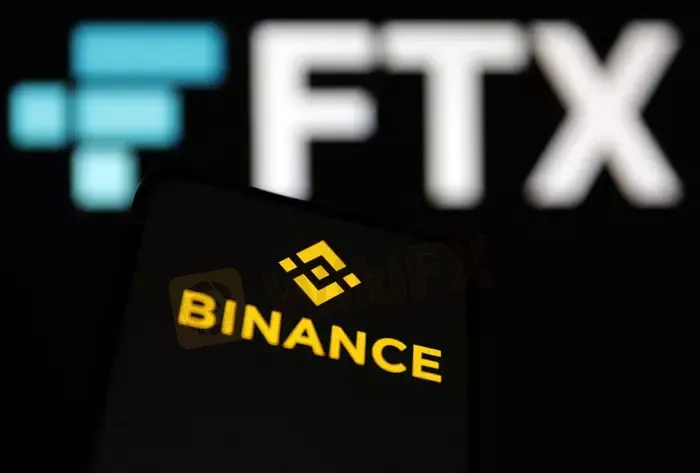简体中文
繁體中文
English
Pусский
日本語
ภาษาไทย
Tiếng Việt
Bahasa Indonesia
Español
हिन्दी
Filippiiniläinen
Français
Deutsch
Português
Türkçe
한국어
العربية
How Binance’s plan to buy FTX unfolded in a matter of days
Abstract:Crypto exchange Binance signed a nonbinding agreement on Tuesday to acquire rival crypto exchange FTX, in a dramatic move that capped off a series of back-and-forth salvos between the CEOs of both companies.

Here are the key developments in the longstanding relationship between Binance and FTX:
* December 2019: Binance invested an undisclosed amount in FTX, which was then a derivatives exchange, CoinDesk reported. Binance also purchased long positions in FTT, FTXs native crypto token.
* July 2021: Binance announced that it was selling its stake in FTX, Fortune reported. As part of that exit, Binance received the equivalent of $2.1 billion in Binances stablecoin and FTT, according to Binance CEO Changpeng Zhao.
* Nov. 2: Crypto news website CoinDesk reported on a leaked balance sheet from Alameda Research, FTX CEO Sam Bankman-Frieds crypto trading firm, which maintains close ties with FTX.
* According to CoinDesk‘s report, $3.66 billion of Alameda’s $14.6 billion in assets are held in “unlocked” FTT. Reuters was unable to independently verify the accuracy of the report or the origin of the leaked balance sheet. Still, investors quickly noticed that Alameda‘s finances appeared to be heavily dependent on FTT, and FTT’s value was in turn heavily dependent on purchases from FTX, the tokens largest buyer.
* Nov. 6, 9:32 a.m. ET: Alameda CEO Caroline Ellison said in a tweet that the “balance sheet info which has been circulating recently” showed only a subset of Alamedas corporate entities. The firm has more than $10 billion in assets that are not reflected in the CoinDesk report, she said.
* Nov. 6, 10:47 a.m. ET: Concern escalated on Sunday when Zhao tweeted that Binance would liquidate its holdings of FTT “due to recent revelations that have come to light,” although he did not specify which revelations he was referring to or how much of the token Binance held.
* Nov 7: In a series of tweets on Monday, Bankman-Fried asserted that “a competitor is trying to go after us with false rumors.”
“FTX is fine. Assets are fine,” he said.
He tagged Zhao in a later tweet, saying “Id love it, @cz_binance, if we could work together for the ecosystem.”
* Nov. 8: In the 72 hours leading up to Tuesday morning, FTX had seen around $6 billion of withdrawals, according to a message to staff sent by Bankman-Fried that was seen by Reuters. Also on Tuesday morning, Bankman-Fried wrote that withdrawals are effectively paused.
Shortly after 11 a.m. ET, Bankman-Fried tweeted that FTX had “come to an agreement on a strategic transaction with Binance for FTX.com,” and that while teams were working on clearing the backlog of withdrawal requests, all assets would be covered 1:1.
Zhao tweeted that there is “a significant liquidity crunch” at FTX and, in order to protect users, Binance signed a nonbinding letter of intent to acquire FTX.com, which does not include FTXs U.S. entity.

Disclaimer:
The views in this article only represent the author's personal views, and do not constitute investment advice on this platform. This platform does not guarantee the accuracy, completeness and timeliness of the information in the article, and will not be liable for any loss caused by the use of or reliance on the information in the article.
Read more

New Zealand's FMA Warns Against "YouTube Crypto Investment Scam"
The Financial Markets Authority (FMA), New Zealand's financial regulator, warns individuals against investment scams that use YouTube channels to promote fraudulent cryptocurrency investment firms/websites. The authority explained on its official website how the YouTube cryptocurrency scam works, providing a step-by-step guide to help people recognize and avoid it. Read HOW THE SCAM WORKS and BE SAFE.

Trading is an Endless Journey
Every trader dreams of quick success, but rushing the process often leads to mistakes. It’s easy to get swept up in the excitement of winning trades or discouraged by unexpected losses. The truth is, mastering the emotional side of trading can be even more important than understanding market analysis or strategies.

How to Know if the Market is Correcting or Reversing?
In trading, distinguishing between a market correction and a market reversal is crucial for making sound decisions. Misjudging one for the other can lead to missed opportunities or significant losses. While both involve price movements, their causes, duration, and implications differ substantially. Understanding these differences can help traders improve their strategies and adapt to market conditions effectively.

RM62k Lost Investment Scam After Joining XRP Community Malaysia on Telegram
A 30-year-old homestay manager from Chendering, Malaysia, fell victim to an online bitcoin investment scam, losing RM62,214.59. According to Kuala Terengganu police chief ACP Azli Mohd Noor, the incident unfolded after the victim joined a Telegram group named “XRP Community Malaysia” on December 19. The group promoted bitcoin investments allegedly powered by Artificial Intelligence (AI).
WikiFX Broker
Latest News
Two Californians Indicted for $22 Million Crypto and NFT Fraud
RM62k Lost Investment Scam After Joining XRP Community Malaysia on Telegram
Victims of Financial Fraud in France Suffer Annual Losses of at Least €500 Million
WikiFX Review: Is Ultima Markets Legit?
Colorado Duo Accused of $8M Investment Fraud Scheme
What Impact Does Japan’s Positive Output Gap Have on the Yen?
Macro Markets: Is It Worth Your Investment?
Trading is an Endless Journey
SEC Warns on Advance Fee Loan Scams in the Philippines
Malaysia Pioneers Zakat Payments with Cryptocurrencies
Currency Calculator


